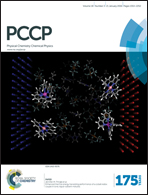Alcohol-soluble interfacial fluorenes for inverted polymer solar cells: sequence induced spatial conformation dipole moment†
Abstract
Three fluorene-based alcohol-soluble organic small molecule electrolytes (SMEs) with different conjugated backbones, namely, TFTN-Br, FTFN-Br and FTTFN-Br, were designed as cathode interfacial layers for inverted polymer solar cells (i-PSCs). The insertion of SMEs to the ITO/active layer interfaces effectively lowered the energy barrier for electron transport and improved the inherent compatibility between the hydrophilic ITO and hydrophobic active layers. Due to these advantages, the device based on poly(3-hexylthiophene) (P3HT):(6,6)-phenyl-C61 butyric acid methyl ester (PC61BM) with TFTN-Br as the cathode interfacial layer achieved an improved power conversion efficiency (PCE) of 3.8%, which is a 26% improvement when compared to the standard device comprising ZnO cathode interfacial layers (PCE = 3.0%). Devices with FTFN-Br and FTTFN-Br also showed an improved PCE of 3.1% and 3.5%, respectively. The variation in device performance enhancement was found to be primarily correlated with the different conformation of their assembly onto the electrode caused by the joint sequence of the polar group of the SMEs, consequently impacting the dipole moment and interface morphology. In addition, introducing SMEs as the cathode interfacial layer also produced devices with long-term stability.


 Please wait while we load your content...
Please wait while we load your content...